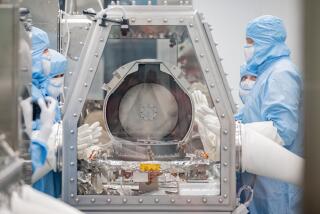NASA’s New Horizons mission reveals Ultima Thule in 3-D
Get out those blue-and-red glasses, space lovers. NASA’s New Horizons mission just revealed a new image of Ultima Thule in 3-D.
The stereo image shows the three-dimensional shape of Ultima Thule, a peanut shaped world about 20 miles long, and the most distant object ever visited by humankind.
The New Horizons spacecraft sped past the Kuiper Belt object on New Year’s Eve, filling its servers with data on Ultima Thule’s size and shape, the number of craters it has, whether it has moons or an atmosphere, and what ices appear on its frozen surface.
Three days after the historic flyby, less than 1% of the data from those observations has been sent back to Earth, and no more is expected for several days.
Beginning Friday, New Horizons will fly almost directly behind the sun in relation to the Earth, said Alan Stern of the Southwest Research Institute and the principal investigator of the mission.
Radio interference from the sun’s outer atmosphere will prevent any data transmissions from the spacecraft until Jan. 10, Stern said.
In the meantime, scientists will continue to puzzle over the images and measurements they do have of this distant and mysterious world, 4 billion miles from Earth.
As the stereo image shows, Ultima Thule is comprised of two spherical objects.
Scientists believe the two objects came together in a slow-motion impact early in the solar system’s history. Neither of the spheres is perfectly round. They both appear to have a significant number of lumps.
It is too soon to tell whether these lumps are caused by craters that excavated parts of its surface, or ridges that rise above it, said Paul Schenk, a New Horizons co-investigator from the Lunar and Planetary Institute in Houston.
“We need to be careful when interpreting images like this,” Schenk said. “We think what we are seeing could be interpreted as ridge structures, but we’ll have to get back to you on that.”
More detailed images that are expected to arrive on Earth later this month and in February should help clarify the small world’s topography, he said.
So far, the team has found no evidence of an atmosphere around Ultima Thule, which is to be expected. It is a small world, roughly the size of the city of Washington, D.C., and unlikely to have even a thin atmosphere like the one on Pluto. But scientists said they will continue to evaluate New Horizons data for any evidence of unexpected gases in Ultima Thule’s vicinity.
There has also been no evidence yet of any moons or satellites orbiting Ultima Thule, which is a bit more frustrating. The discovery of any moon on any orbit in the vicinity of the bi-lobed object would allow scientists to determine its mass and density, said Mark Showalter, a New Horizons co-investigator from the SETI Institute in Mountain View, Calif. That information would in turn offer clues to the composition of its interior, he said.
The discovery of a moon or moons would also help scientists understand Ultima Thule’s spin rate.
Ultima Thule currently takes about 15 hours to complete one full rotation on its axis, but computer models suggest that it was spinning much faster when the two objects first came together, Showalter said. It is likely that gravity from a nearby object or several objects caused it to slow down.
“Something had to put the brakes on it,” he said.
He is hopeful that images of Ultima Thule in its immediate environment will hold some answers.
“As soon as they hit the ground we will look to see if we can find a moon or two in that data set,” he said.
Future information will also reveal more details about the color differences on Ultima Thule’s surface and allow scientists to create maps of its surface composition, researchers said.
It is clear that the surface of Ultima Thule is a deep red color, but scientists cannot say definitively why. They should know soon.
For now, the science team will analyze and try to draw additional conclusions from the data it does have.
Do you love science? I do! Follow me @DeborahNetburn and “like” Los Angeles Times Science & Health on Facebook.
MORE IN SCIENCE







